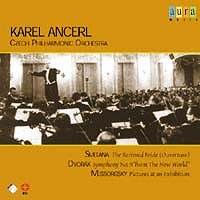How times change. When
I began collecting records in the 1960s Karel Ančerl’s “New World”
was available from Supraphon and was not highly regarded. Edward
Greenfield, in a Radio 3 survey of available "New Worlds"
even dismissed it as "a rather dull performance", and the
early editions of the Penguin Guide to Bargain Records had it well down
in the list. Nowadays there are critics
who rate it as the finest “New World” ever and most companies specialising
in the reissue of radio archive material try to have an Ančerl
“New World” in their books.
Has it changed or have we? Well, it
can’t have changed so we must have. For one thing, in those days
a "normal" "New World" went in for a wide range
of speeds in the outer movements, with the flute theme in the first
movement, in particular, frequently bringing the music to a standstill.
Any new recording which did this would probably be condemned on principle
and certain red-blooded romantic recordings that were mainstays of the
LP catalogue, the Fricsay for instance, have seen their numbers go down.
At the other end of the spectrum was the Toscanini which blew away the
cobwebs of tradition and was widely venerated for doing so. This was
my introduction to the work and it took a long time before I could accept
and eventually prefer other more gentle but equally un-romantic views.
In this context a performance which played the score as faithfully as
Toscanini but without his fearsome energy risked being dismissed as
blandly unimaginative.
The Lugano performance
recorded here is certainly a thoroughly energetic affair, with noisy
brass climaxes that have you wondering if Ančerl had been listening
to Toscanini. The first movement bowls along splendidly, the lyrical
melodies beautifully phrased with little concession
over tempo. The “largo” is taken at a flowing speed and is notable for
the way in which the “piů mosso” sections move on more than we
usually hear. However, though I wouldn’t call this bland, it seems to
me to lack the spell-binding qualities of another recently revived
performance, also underestimated in its day, that by Nikolai Malko.
Timings are not everything but Malko, in the 12’20" of his 1956
Philharmonia recording (CZS 7243 5 75121 2), let alone in the 13’39"
of his quite miraculously beautiful 1948
Danish State Radio Orchestra recording (DACOCD 549-550) finds so much
more in the music than Ančerl in his 10’27”.
If there is a movement in which the Czechs seem to
possess some secret denied to the rest of us it is the third, where
they quite rightly recognise that the trio is more of a fast sousedskà
than a waltz – hear how the third beat is sprung. The finale is also
very fine with all Dvořák’s references to themes from earlier
movements beautifully balanced against each other and sounding properly
symphonic for once. I reacted in a similar way to Malko’s finale, however
(this time with a preference for the Philharmonia version) and felt
that his more spacious approach gave one more time to savour the music.
So it was disconcerting to discover that
there is only 2 seconds’ difference between them! Checking them side
by side I concluded that Ančerl gives the impression of more speed
because he sometimes moves ahead impetuously, and draws back slightly
in the clarinet theme, whereas Malko’s steady beat has the effect
that after a time you don’t notice the tempo at all and simply hear
the music. I also noticed that, while the Czech strings may be wonderful
no one could accuse their trumpeter of subtlety and their clarinettist
lacks the liquid beauty of the London player’s tone.
All in all, then, while this is certainly a fine "New
World" it doesn’t seem to me to possess those special qualities
that its provenance might lead you to expect. The recording is really
very good for the date. Alas, at the beginning of the "Bartered
Bride" overture the engineers seem to have been caught still positioning
the mikes and there are some bumps and squeaks during the opening bars.
A sizzling performance, maybe just a little too fast for ideal clarity,
given the reverberant acoustic.
The truly enthralling
performance here is actually the Mussorgsky, a swift and vividly characterised
reading. It is clear from the outset that Ančerl is not going to
hang around and in some of the faster movements – “Limoges” and “The
Hut on Fowl’s Legs” – the players take off in flights of collective
frenzy, while this is one of the rare performances in which the "Old
Castle" does not seem too long. The two Jews are thoroughly acrimonious
and the control over the dynamics in "Catacombs" is notable.
Fine as all this is, in
the last resort I can’t quite claim buried treasure status for it. Ančerl’s
interpretations of these works are already known in stereo versions,
and he was pretty consistent between one performance and another. New
additions to the Ančerl discography
will be warmly welcomed and can I point out that, if a Dvořák “Te
Deum” is not available from Czech sources, Italian Radio have a Turin
performance of it with Marcella Pobbe and Nicola Rossi-Lemeni as soloists,
in which he drew string playing from the local orchestra of a
vibrancy not far behind that of the CPO itself.
Christopher Howell


